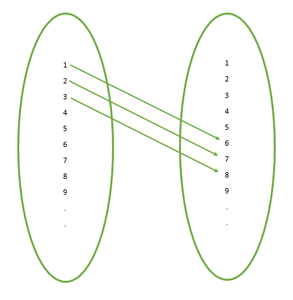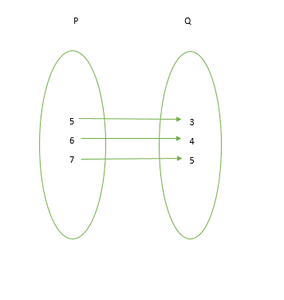问题12.设A = {x,y,z}和B = {a,b}。查找从A到B的关系总数。
解决方案:
The total number of relations that can be defined from a set A to a set B is the number of possible subsets of A × B.
If n(A) = p and n(B) = q, then n(A × B) = pq.
So, the total number of relations is 2pq.
n(A) = 3 and n(B) = 2 ⇒ n(A × B) = 3 × 2 = 6
∴ Total number of relations = 26 = 64
问题13。令R是从N到N的关系,由R = {((a,b):a,b∈N and a = b 2 }}定义。
以下陈述正确吗?
(i)(a,a)∈R对于所有a∈N
(ii)(a,b)∈R⇒(b,a)∈R
(iii)(a,b)∈R和(b,c)∈R⇒(a,c)∈R
解决方案:
Given: R = {(a, b): a, b ∈ N and a = b2}.
(i) (a, a) ∈ R for all a ∈ N
Here, take b = 2
a = b2 = 22 = 4
∴ (4, 2) R but (2, 2) ∉ R
As, 22 ≠ 2
So,
No, the statement is false.
(ii) (a, b) ∈ R ⇒ (b, a) ∈ R
Here, take b = 2
a = b2 = 22 = 4
∴ (4, 2) ∈ R but (2, 4) ∉ R
As, 42 ≠ 2
So,
No, the statement is false.
(iii) (a, b) ∈ R and (b, c) ∈ R ⇒ (a, c) ∈ R
Here, take b = 4
a = b2 = 42 = 16
(16, 4)∈ R
Now, b = c2
4 = c2
c = -2 ∉ N
(4, 2) ∈ R
But (16, 2) ∉ R
As, 22 ≠ 16
So,
No, the statement is false.
问题14.让A = {1,2,3,…。,14}。通过R = {(x,y):3x – y = 0,其中x,y∈A}来定义集合A上的关系。使用箭头图描述这种关系。写下其域,共域和范围。
解决方案:
Given: R = {(x, y): 3x – y = 0, where x, y ∈ A}
A = {1, 2, 3,…,14}
As, y = 3x
∴ R = {(x, 3x): where x, 3x ∈ A}
R = {(1, 3×1), (2, 3×2), (3, 3×3), (4, 3×4)}
Note: We cannot include (5, 3×5) as 15 ∉ A
R = {(1, 3), (2, 6), (3, 9), (4, 12)}

So,
Domain of relation R = {1, 2, 3, 4}
Co-Domain of relation R = {1, 2, 3,…,14} = A
Range of relation R = {3, 6, 9, 12}
问题15:通过R = {(x,y):y = x + 5,在自然数的集合N上定义关系R,x是自然数小于4,x,y∈N}。使用(i)名册形式(ii)箭头图描述这种关系。写下R的域和范围。
解决方案:
R = {(x, y): y = x + 5, x is a natural less than 4, x, y ∈ N}
Natural numbers less than 4 are 1, 2 and 3.
On putting x = 1, y = 1 + 5 = 6
On putting x = 2, y = 2 + 5 = 7
On putting x = 3, y = 3 + 5 = 8
(i) R = {(1, 6), (2, 7), (3, 8)}
(ii) The arrow diagram represent the relation(R):
So,
Domain of relation R = {1, 2, 3}
Range of relation R = {6, 7, 8}

问题16:A = {1,2,3,5},B = {4,6,9}。通过R = {(x,y)定义从A到B的关系R:x和y之差为奇数,x∈A,y∈B}。以名册形式写R。
解决方案:
Given:
Relation R from A to B by R = {(x, y): the difference between x and y is odd, x ∈ A, y ∈ B}
A = {1, 2, 3, 5} and B = {4, 6, 9}
For x = 1:
y – x = 4 – 1 = 3 which is odd ⇒ 4 ∈ y
y – x = 6 – 1 = 5 which is odd ⇒ 6 ∈ y
y – x = 9 – 1 = 8 which is even ⇒ 8 ∉ y
For x = 2:
y – x = 4 – 2 = 2 which is even ⇒ 4 ∉ y
y – x = 6 – 2 = 4 which is even ⇒ 6 ∉ y
y – x = 9 – 2 = 7 which is odd ⇒ 8 ∈ y
For x = 3:
y – x = 4 – 3 = 1 which is odd ⇒ 4 ∈ y
y – x = 6 – 3 = 3 which is odd ⇒ 6 ∈ y
y – x = 9 – 3 = 6 which is even ⇒ 8 ∉ y
For x = 5:
x – y = 5 – 4 = 1 which is odd ⇒ 4 ∈ y
y – x = 6 – 5 = 1 which is odd ⇒ 6 ∈ y
y – x = 9 – 5 = 4 which is even ⇒ 8 ∉ y
∴ R = {(1, 4), (1, 6), (2, 8), (3, 4), (3, 6), (5, 4), (5, 6)}
Domain of relation R = {1, 2, 3, 5}
Range of relation R = {4, 6, 8}
问题17:以花名册形式写关系式R = {(x,x 3 ):x是小于10的质数。
解决方案:
Given: R = {(x, x3): x is a prime number less than 10}
Prime numbers less than 10 are 2, 3, 5 and 7
∴ R = {(2, 23), (3, 33), (5, 53), (7, 73)}
R = {(2, 8), (3, 27), (5, 125), (7, 343)}
So,
Domain of relation R = {2, 3, 5, 7}
Range of relation R = {8, 27, 125, 343}
问题18。令A = {1,2,3,4,5,6}。设R为与A定义的关系
R = {(a,b):a,b∈A,b可被a整除}
(i)以花名册形式写R
(ii)找出R的域
(iii)找出R的范围。
解决方案:
Given:
R= {(a, b): a, b ∈ A, b is exactly divisible by a}
A= {1, 2, 3, 4, 5, 6}
Here,
6 is exactly divisible by 1, 2, 3 and 6
5 is exactly divisible by 1 and 5
4 is exactly divisible by 1, 2 and 4
3 is exactly divisible by 1 and 3
2 is exactly divisible by 1 and 2
1 is exactly divisible by 1
(i) R = {(1, 1), (2, 1), (2, 2), (3, 1), (3, 3), (4, 1), (4, 2),
(4, 4), (5, 1), (5, 5), (6, 1), (6, 2), (6, 3), (6, 6)}
(ii) Domain of relation R = {1, 2, 3, 4, 5, 6}
(iii) Range of relation R = {1, 2, 3, 4, 5, 6}
问题19。该图显示了集合P和Q之间的关系。将该关系写在
(i)设置建造者表格
(ii)名册表格
(iii)它的范围和范围是什么?

解决方案:
(i) Since 5 – 3 = 6 – 4 = 7 – 5 = 2
∴ x – y = 2 where x ∈ P and y ∈ Q
So,
R = {(x, y): x – y = 2, x ∈ P, y ∈ Q}
(ii) Now, R = {(5, 3), (6, 4), (7, 5)}
(iii) Domain of relation R = {5, 6, 7}
Range of relation R = {3, 4, 5}
问题20:设R是Z上由R = {((a,b)Z,a – b是整数}}所定义的关系。找到R的域和范围。
解决方案:
Given: R = {(a, b) ∈ Z, a – b is an integer}
Z denotes integer, and here a and b both are integers
We know that difference of two integers is always an integer
∴ a and b can be any integer in relation R
The domain of relation R = Z (as a ∈ Z)
The range of relation R = Z (as b ∈ Z)
问题21:对于由规则(a,b)∈R 1 <=> 1 + ab> 0在R上定义的关系R 1 ,证明:(a,b)∈R 1和(b,c)∈R 1⇒(A,C)∈R 1不是适用于所有的a,b,C∈R.
解决方案:
To prove: (a, b) ∈ R1 and (b, c) ∈ R1 ⇒(a, c)∈ R1 is not true for all a, b, c R.
Given: R1 = {(a, b)∈ R <=>1 + ab > 0}
Let a = 1, b = -0.5, c = -4
Here, (1, -0.5) ∈ R1 [∵ 1+(1×-0.5) = 0.5 > 0]
And, (-0.5, -4) ∈ R1 [∵ 1+(-0.5×-4) = 3 > 0]
But, (1, -4) ∉ R1 [∵ 1+(1×-4) = -3 < 0]
∴ (a, b) ∈ R1 and (b, c) ∈ R1 ⇒(a, c) R1 is not true for all a, b, c ∈ R
Hence, Proved.
Note: Here, R1 is a relation whereas R denotes a real number.
问题22.设R是由(a,b)定义的N x N的关系R(c,d)对于所有(a,b),(c,d)∈N的a + d = b + c xN。
显示:
一世。 (a,b)对所有(a,b)∈N x N的R(a,b)
ii。 (a,b)R(c,d)⇒(c,d)R(a,b)对所有(a,b),(c,d)∈N x N
iii。 (a,b)R(c,d)和(c,d)R(e,f)⇒(a,b)所有(a,b),(c,d)的R(e,f),( e,f)∈N×N
解决方案:
Given:
(a, b) R (c, d) a + d = b + c for all (a, b), (c, d) ∈ N x N
(i) (a, b) R (a, b)
a + b = b + a for all (a, b) ∈ N x N
∴ (a, b) R (a, b) for all (a, b) ∈ N x N
(ii) (a, b) R (c, d)
a + d = b + c ⇒ c + b = d + a
(c, d) R (a, b) for all (c, d), (a, b) ∈ N x N
(iii) (a, b) R (c, d) and (c, d) R (e, f)
a + d = b + c and c + f = d + e
a + d + c + f = b + c + d + e
a + f = b + c + d + e – c – d
a + f = b + e
(a, b) R (e, f) for all (a, b), (c, d), (e, f) ∈ N × N